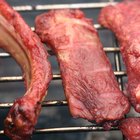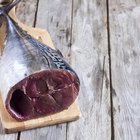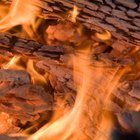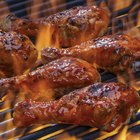
Barbecuing meat is an art form that brings out the passion in many an outdoor cook. The meat is cooked low and slow, with the heat source somewhere between 180 and 250 degrees Fahrenheit. Wet wood chips mixed with the charcoal impart a woody smoke flavor to the barbecue. The trick to barbecuing with wood and charcoal is keeping the temperature down and providing constant smoke. Deciduous hardwoods are most commonly used for barbecuing, with choices including hickory, mesquite, oak, pecan and fruit woods such as apple, cherry, pear and peach.
Step 1
Select wood chips from a tree species that pairs well with the type of meat you wish to barbecue. The mild flavors of alder and maple wood go well with fish, while pork is enhanced particularly well with smoke from fruit wood such as apple or peach. Fruit woods are also commonly used for chicken, but chicken can also take on the bold flavors of mesquite and hickory. Try cherry wood, mesquite or hickory to punch up the flavors of beef. These are only basic guidelines; feel free to mix wood chips from different species and experiment with different flavor combinations.
Step 2
Soak the wood chips in a bowl of water for about 15 to 30 minutes. This prevents the wood from catching fire and instead encourages smoking around the meat.
Step 3
Fill a metal pan or a disposable aluminum foil pan with water and place it on one side of the grill bottom. This pan of water creates steam that keeps the meat moist and helps it absorb more of the smoke flavor.
Step 4
Add charcoal briquettes to the other side of the grill, directly beside the water pan. Light the charcoal and allow the fire to die down. Spread the coals when the flames die out and the outside of the charcoal turns ashy gray-white. The charcoal must be spread thin to keep the heat down because barbecue, by definition, is cooked over low heat no more than about 250 F.
Step 5
Place about two handfuls of the wet wood chips directly on top of the charcoal briquettes. Spread them evenly over all the charcoal, leaving the center open for the water pan. The wood should start smoking quickly after adding them to the grill. Replace the grill grates to allow them to preheat. If your grill has two removable grates, do not place a grate over the charcoal and wood chips so you'll have easier access later.
Step 6
Add the seasoned meat to the grill above the water pan when the wood chips start smoking well. Leave space between each piece of meat so the smoke can travel throughout the grill. Do not place the meat directly over the charcoal and wood; place it over the water pan so the heat source is indirect and the meat cooks slowly.
Step 7
Put the lid on the grill to keep the smoke contained around the meat. Turn the vent slightly so some smoke can escape. The lid also reduces the level of oxygen inside the grill, which encourages the wood to smolder and smoke rather than catch fire.
Step 8
Add more wood and charcoal as they burn down. Try to maintain a constant level of smoke within the barbecue grill. This is easiest to do if your grill has two removable grates or a folding grate. If you only have one grate, you must use tongs and hot pads to lift or tilt the grate for access.
Step 9
Remove the meat from the heat when done to your preference. The cooking time varies greatly depending on the type of meat, the meat thickness and, in the case of beef, your preference for rare, medium or well done meat. While it might only take 2 hours to cook a whole pork loin, it can take up to 12 hours to barbecue a whole pig.
Related Articles

How to Smoke Food With Cedar Chips

How Do I Start a Mesquite Wood BBQ?

How to Cook Ribs Over an Open Pit

How to Use Wood Chips in a Smoker

How to Use Mesquite Chips on an ...

How to Smoke Tuna

How to Make a Wood Fire in a Barbeque ...

How to Smoke Pollock

How to Smoke Haddock

How to Cook Beef Teriyaki Jerky in a ...

How to Smoke Pork on a Gas Grill

How to Relight BBQ Charcoal

How to Smoke Deer Venison Shoulder

How to Barbecue Roast Beef

How to Cook Chicken Bratwurst

How to Start a charcoal fire without ...

Cooking Times for Smoking Meat in an ...

How to Cook Chicken in a Crockpot & ...

How to Cook a Brisket in the Ground

Grilling Instructions for Rib-Eye Steak
References
Tips
- If you find that the wood chips still burn too fast despite adding them while wet, you can create a foil packet for the next time. Add the wet wood chips to the center of a large piece of aluminum foil. Gather the ends of the foil over the wood chips and make 1-inch folds down to the wood chips. Fold in the ends in the same way. Poke several holes or slits in the top of the foil packet -- the seamless side -- to allow smoke to escape. Place the packet in the grill seam side down.
- Some charcoal grills have a built-in smoking chamber that eliminates the need for the water pans. The meat is cooked inside the smoking chamber, while the coals and wood are burned in the main part of the grill. The smoke is pushed through the smoking chamber, but the meat cooks over indirect heat.
Warnings
- Avoid wood such as pine and cedar, and any others that contain sap and tar.
Writer Bio
A former cake decorator and competitive horticulturist, Amelia Allonsy is most at home in the kitchen or with her hands in the dirt. She received her Bachelor's degree from West Virginia University. Her work has been published in the San Francisco Chronicle and on other websites.
Photo Credits
Jupiterimages/Photos.com/Getty Images